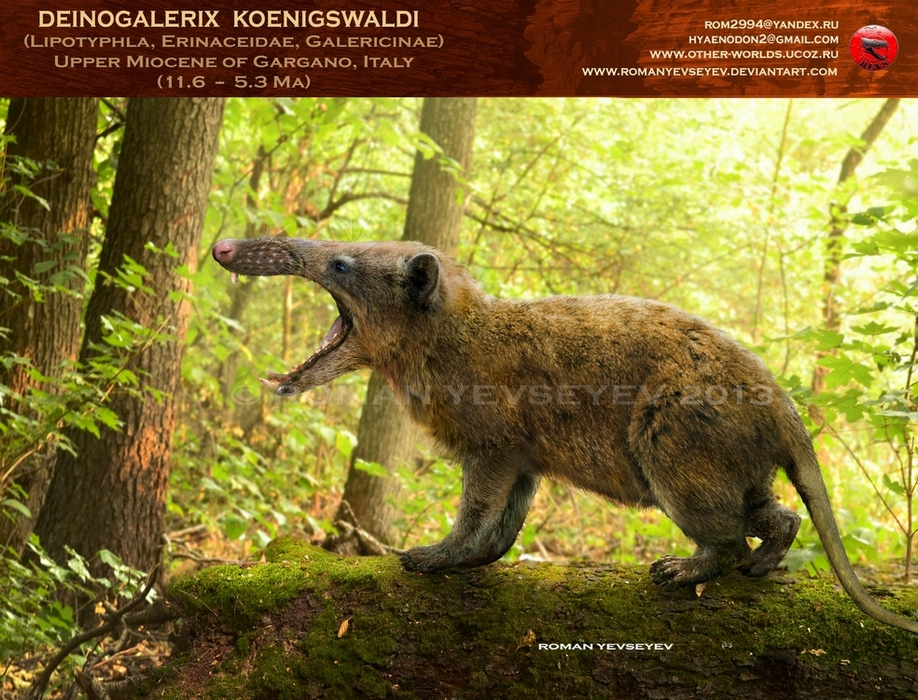Post by Infinity Blade on Mar 27, 2015 6:47:05 GMT 5
Deinogalerix spp.

© @ RomanYevseyev
A life restoration of D. koenigswaldi.
Temporal range: Late Miocene
Scientific classification:
Domain: Eukaryota
(unranked): Unikonta
(unranked): Opisthokonta
(unranked): Holozoa
(unranked): Filozoa
Kingdom: Animalia
Subkingdom: Eumetazoa
(unranked): Bilateria
Superphylum: Deuterostomia
Phylum: Chordata
Infraphylum: Gnathostomata
Clade: Eugnathostomata
Clade: Teleostomi
Superclass: Tetrapoda
Clade: Reptiliomorpha
Clade: Amniota
Clade: Synapsida
Order: Therapsida
Clade: Theriodontia
Clade: Eutheriodonta
Suborder: Cynodontia
Clade: Epicynodontia
Infraorder: Eucynodontia
Parvorder: Probainognathia
Superfamily: Chiniquodontoidea
Clade: Prozostrodontia
Clade: Mammaliaformes
Class: Mammalia
Clade: Holotheria
Superlegion: Trechnotheria
Legion: Cladotheria
Sublegion: Zatheria
Infralegion: Tribosphenida
Subclass: Theria
Clade: Eutheria
Infraclass: Placentalia
Subcohort: Exafroplacentalia
Magnorder: Boreoeutheria
Superorder: Laurasiatheria
Order: Erinaceomorpha
Family: Erinaceidae
Subfamily: Galericinae
Genus: †Deinogalerix
Species: †D. brevirostris
†D. freudenthali
†D. intermedius
†D. koenigswaldi
†D. minor
†D. masinii
Deinogalerix is an extinct genus of erinaceid that lived in Italy during the Late Miocene. It was closely related to hedgehogs, as the phylogenetic differences between Deinogalerix and hedgehogs only begin at their respective subfamilies; Deinogalerix being a member of the Galericinae and hedgehogs constituting the Erinaceinae. The holotype specimen's skull was ~21cm long and the rostrum was pretty longirostrine. Supposedly, the total body length was ~60cm long, meaning the head accounted for a little over a third of the entire animal's total body length.
An attempt was made to discern the ecology of Deinogalerix. Freudenthal (1972) noted the gigantism of rodents among the Miocene fauna of Gargano. It was stated that predators such as a taxon of otter found in the area and crocodiles were either unsuitable predators of the giant rodents or were too uncommon to have had a substantial ramifications on their populations. Despite their prevalence, birds of prey were, in any case, unable to prevent the evolution of these giant rodents.
It is difficult to conform to the notion that a creature as large as Deinogalerix with large, well-developed incisors would have been limited to insectivory, yet it was also taken into account that the leg morphology of Deinogalerix did not suggest an animal capable of swift locomotion useful for pursuing and apprehending prey. Freudenthal (1972) hence concluded that Deinogalerix was a scavenger that utilized its large incisors for carcass dismemberment. Likewise, it was hence not envisioned as a suitable predator of the giant rodents, ergo it was also concluded that these extinct rodents (and Deinogalerix for that matter) attained their notably large body size due to a lack of suitable predators.[1]
Notwithstanding Freudenthal (1972)'s conclusion in regards to the ecology of Deinogalerix, it should be noted that terrestrial obligate scavengers are not likely at all[2] and assertions on the Internet claim it could have hunted small mammals, reptiles, and birds (if it were to go after vertebrate prey at least).
References:
[1] Freudenthal M. (1972). "Deinogalerix koenigswaldi nov. gen., nov. spec., a giant insectivore from the Neogene of Italy"
[2] Ruxton & Houston (2004). "Obligate vertebrate scavengers must be large soaring fliers"

© @ RomanYevseyev
A life restoration of D. koenigswaldi.
Temporal range: Late Miocene
Scientific classification:
Domain: Eukaryota
(unranked): Unikonta
(unranked): Opisthokonta
(unranked): Holozoa
(unranked): Filozoa
Kingdom: Animalia
Subkingdom: Eumetazoa
(unranked): Bilateria
Superphylum: Deuterostomia
Phylum: Chordata
Infraphylum: Gnathostomata
Clade: Eugnathostomata
Clade: Teleostomi
Superclass: Tetrapoda
Clade: Reptiliomorpha
Clade: Amniota
Clade: Synapsida
Order: Therapsida
Clade: Theriodontia
Clade: Eutheriodonta
Suborder: Cynodontia
Clade: Epicynodontia
Infraorder: Eucynodontia
Parvorder: Probainognathia
Superfamily: Chiniquodontoidea
Clade: Prozostrodontia
Clade: Mammaliaformes
Class: Mammalia
Clade: Holotheria
Superlegion: Trechnotheria
Legion: Cladotheria
Sublegion: Zatheria
Infralegion: Tribosphenida
Subclass: Theria
Clade: Eutheria
Infraclass: Placentalia
Subcohort: Exafroplacentalia
Magnorder: Boreoeutheria
Superorder: Laurasiatheria
Order: Erinaceomorpha
Family: Erinaceidae
Subfamily: Galericinae
Genus: †Deinogalerix
Species: †D. brevirostris
†D. freudenthali
†D. intermedius
†D. koenigswaldi
†D. minor
†D. masinii
Deinogalerix is an extinct genus of erinaceid that lived in Italy during the Late Miocene. It was closely related to hedgehogs, as the phylogenetic differences between Deinogalerix and hedgehogs only begin at their respective subfamilies; Deinogalerix being a member of the Galericinae and hedgehogs constituting the Erinaceinae. The holotype specimen's skull was ~21cm long and the rostrum was pretty longirostrine. Supposedly, the total body length was ~60cm long, meaning the head accounted for a little over a third of the entire animal's total body length.
An attempt was made to discern the ecology of Deinogalerix. Freudenthal (1972) noted the gigantism of rodents among the Miocene fauna of Gargano. It was stated that predators such as a taxon of otter found in the area and crocodiles were either unsuitable predators of the giant rodents or were too uncommon to have had a substantial ramifications on their populations. Despite their prevalence, birds of prey were, in any case, unable to prevent the evolution of these giant rodents.
It is difficult to conform to the notion that a creature as large as Deinogalerix with large, well-developed incisors would have been limited to insectivory, yet it was also taken into account that the leg morphology of Deinogalerix did not suggest an animal capable of swift locomotion useful for pursuing and apprehending prey. Freudenthal (1972) hence concluded that Deinogalerix was a scavenger that utilized its large incisors for carcass dismemberment. Likewise, it was hence not envisioned as a suitable predator of the giant rodents, ergo it was also concluded that these extinct rodents (and Deinogalerix for that matter) attained their notably large body size due to a lack of suitable predators.[1]
Notwithstanding Freudenthal (1972)'s conclusion in regards to the ecology of Deinogalerix, it should be noted that terrestrial obligate scavengers are not likely at all[2] and assertions on the Internet claim it could have hunted small mammals, reptiles, and birds (if it were to go after vertebrate prey at least).
References:
[1] Freudenthal M. (1972). "Deinogalerix koenigswaldi nov. gen., nov. spec., a giant insectivore from the Neogene of Italy"
[2] Ruxton & Houston (2004). "Obligate vertebrate scavengers must be large soaring fliers"








